The AMD Ryzen 3 1300X and Ryzen 3 1200 CPU Review: Zen on a Budget
by Ian Cutress on July 27, 2017 9:30 AM EST- Posted in
- CPUs
- AMD
- Zen
- Ryzen
- Ryzen 3
- Ryzen 3 1300X
- Ryzen 3 1200
Benchmarking Performance: CPU System Tests
Our first set of tests is our general system tests. These set of tests are meant to emulate more about what people usually do on a system, like opening large files or processing small stacks of data. This is a bit different to our office testing, which uses more industry standard benchmarks, and a few of the benchmarks here are relatively new and different.
All of our benchmark results can also be found in our benchmark engine, Bench.
PDF Opening
First up is a self-penned test using a monstrous PDF we once received in advance of attending an event. While the PDF was only a single page, it had so many high-quality layers embedded it was taking north of 15 seconds to open and to gain control on the mid-range notebook I was using at the time. This put it as a great candidate for our 'let's open an obnoxious PDF' test. Here we use Adobe Reader DC, and disable all the update functionality within. The benchmark sets the screen to 1080p, opens the PDF to in fit-to-screen mode, and measures the time from sending the command to open the PDF until it is fully displayed and the user can take control of the software again. The test is repeated ten times, and the average time taken. Results are in milliseconds.
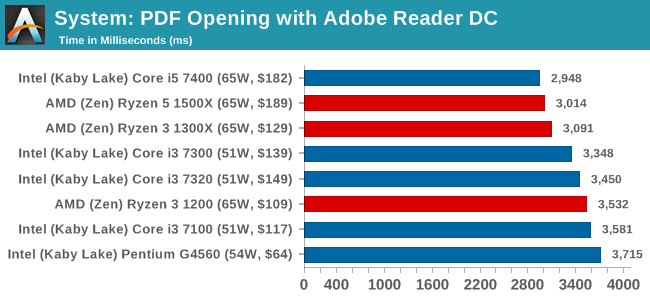
FCAT Processing: link
One of the more interesting workloads that has crossed our desks in recent quarters is FCAT - the tool we use to measure stuttering in gaming due to dropped or runt frames. The FCAT process requires enabling a color-based overlay onto a game, recording the gameplay, and then parsing the video file through the analysis software. The software is mostly single-threaded, however because the video is basically in a raw format, the file size is large and requires moving a lot of data around. For our test, we take a 90-second clip of the Rise of the Tomb Raider benchmark running on a GTX 980 Ti at 1440p, which comes in around 21 GB, and measure the time it takes to process through the visual analysis tool.
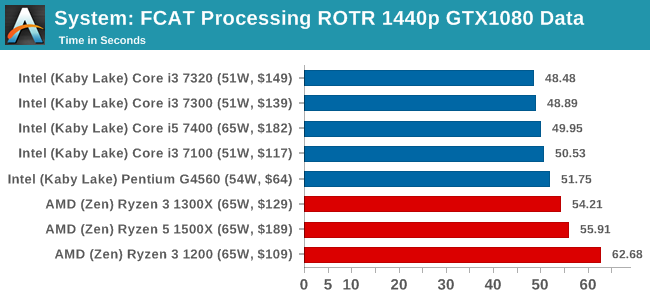
Dolphin Benchmark: link
Many emulators are often bound by single thread CPU performance, and general reports tended to suggest that Haswell provided a significant boost to emulator performance. This benchmark runs a Wii program that ray traces a complex 3D scene inside the Dolphin Wii emulator. Performance on this benchmark is a good proxy of the speed of Dolphin CPU emulation, which is an intensive single core task using most aspects of a CPU. Results are given in minutes, where the Wii itself scores 17.53 minutes.
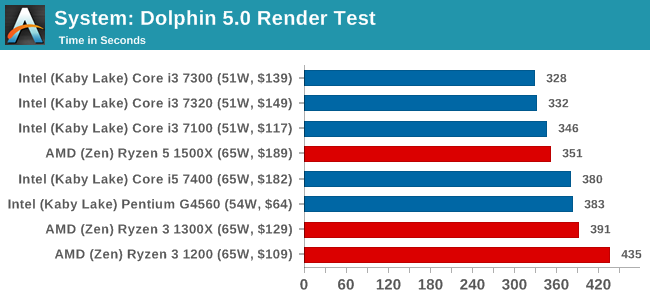
3D Movement Algorithm Test v2.1: link
This is the latest version of the self-penned 3DPM benchmark. The goal of 3DPM is to simulate semi-optimized scientific algorithms taken directly from my doctorate thesis. Version 2.1 improves over 2.0 by passing the main particle structs by reference rather than by value, and decreasing the amount of double->float->double recasts the compiler was adding in. It affords a ~25% speed-up over v2.0, which means new data.
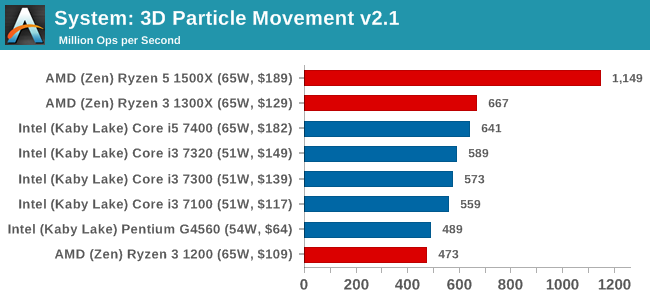
DigiCortex v1.20: link
Despite being a couple of years old, the DigiCortex software is a pet project for the visualization of neuron and synapse activity in the brain. The software comes with a variety of benchmark modes, and we take the small benchmark which runs a 32k neuron/1.8B synapse simulation. The results on the output are given as a fraction of whether the system can simulate in real-time, so anything above a value of one is suitable for real-time work. The benchmark offers a 'no firing synapse' mode, which in essence detects DRAM and bus speed, however we take the firing mode which adds CPU work with every firing.
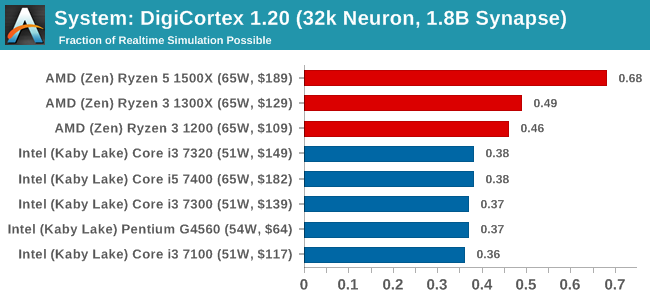
Agisoft Photoscan 1.0: link
Photoscan stays in our benchmark suite from the previous version, however now we are running on Windows 10 so features such as Speed Shift on the latest processors come into play. The concept of Photoscan is translating many 2D images into a 3D model - so the more detailed the images, and the more you have, the better the model. The algorithm has four stages, some single threaded and some multi-threaded, along with some cache/memory dependency in there as well. For some of the more variable threaded workload, features such as Speed Shift and XFR will be able to take advantage of CPU stalls or downtime, giving sizeable speedups on newer microarchitectures.
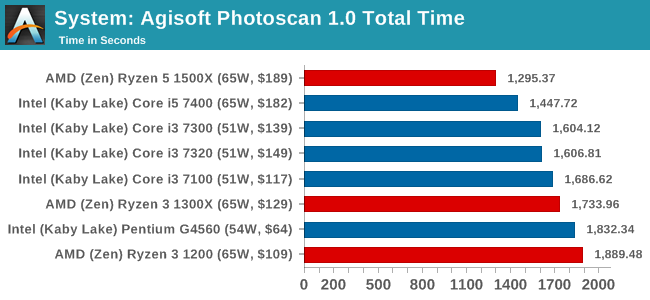










140 Comments
View All Comments
MajGenRelativity - Thursday, July 27, 2017 - link
You make a couple good points. Ryzen 3 is definitely on my watchlistiwod - Thursday, July 27, 2017 - link
What are the Power Load for each CPU and not whole system? Zen is more SoC like and harder to compare to Intel.Ian Cutress - Thursday, July 27, 2017 - link
System is variable. CPU numbers in a CPU review.ampmam - Thursday, July 27, 2017 - link
Great review but biased conclusion. Any idiot can sense it.MrCommunistGen - Thursday, July 27, 2017 - link
For us idiots, can you possibly elaborate what bias you're seeing?vMax65 - Thursday, July 27, 2017 - link
ampmam, good to know you are an idiot...Great review Ian.Ian Cutress - Thursday, July 27, 2017 - link
Biased in what way? I've been called an Intel shill and an AMD shill this week, will be glad to listen to what you think.Oxford Guy - Thursday, July 27, 2017 - link
Then don't open yourself up for these accusations by doing things like kneecapping Zen with 2400 speed RAM.If you think 2400 speed RAM is more beneficial than not then, at least, show the best case results for 3200 speed RAM and say "See — it's not important"
It's not good to see the same site that overclocking by telling people testing for serious stability isn't important and which pumps unwise levels of voltage in hobbling the RAM that's used to test Zen, a platform that most everyone knows benefits more from faster RAM than Intel does.
silverblue - Friday, July 28, 2017 - link
Perhaps it does, but it's not massive. Also, Ian did say he would test at faster settings at a later date.RAM prices are quite high at the moment for the higher clocked parts, which brings about an interesting observation - the Ryzen 3 is the cheapest part of this entire setup.
Oxford Guy - Saturday, July 29, 2017 - link
The RAM that he used was rated at 3000 and he chose to downclock it.